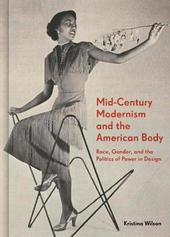
|
Mid-Century Modernism and the American Body: Race, Gender, and the Politics of Power in Design
Hardback
Main Details
Description
The first investigation of how race and gender shaped the presentation and marketing of Modernist decor in postwar America In the world of interior design, mid-century Modernism has left an indelible mark still seen and felt today in countless open-concept floor plans and spare, geometric furnishings. Yet despite our continued fascination, we ra
Author Biography
Kristina Wilson is professor of art history at Clark University. She is the author of The Modern Eye and Livable Modernism. Instagram @kristinawilsonartdesign
Reviews"[An] insightful new book . . . [Mid-Century Modernism and the America Body] points out how many midcentury furnishings and magazine advertisements used demeaning images of women and people of color. The book highlights undeservedly obscure Black designers as well."---Eve M. Kahn, New York Times "Midcentury modernism isn't merely a style characterized by clean lines, open floor plans, graphic use of color, and overt minimalism. Overtones of the movement are both radical and racial, argues author Kristina Wilson, making heretofore largely unexplored connections between race, gender, and modernist decor. Wilson [is] uniquely qualified to chart the journey."---Katherine Burns Olson, ArchitecturalDigest.com "Mid-Century Modernism and the American Body gives the ubiquitous decorating style the historical context it deserves."---Rebecca Onion, Slate "Wilson's deep knowledge of and scholarship in modern design are evident in this book's precisely articulated argument. . . . Wilson's archival research and careful interrogation of relevant texts and images compels readers to see the powerful messages embedded in marketing materials in a fresh way. . . . Essential reading for students of sociology as well as design. " * Library Journal * "Mid-Century Modernism and the American Body by Kristina Wilson critiques the Fifties through: books/magazines, home/furniture designs, manufactured Kitsch, which consumers purchased or at least lusted after...[The book] is a worthwhile read"---Jean Bundy, Anchorage Press "A provocative analysis of race and gender during the Modernist movement in postwar America. Written in accessible language, yet supported by notable scholarly sources, Mid-Century Modernism and the American Body is a compelling read for the design student, mid-century enthusiast, and those interested in historical revisionism...A fascinating and important read for a popular audience."---Erika Balcombe, Spacing Vancouver "Tantalizingly illustrated with over 150 images taken from diverse design sources, Wilson's book offers a beautiful and destabilizing "counter-history" of modernism that forces us to reconsider the sources and motivations behind the decorative revivalisms we hold dear."---Kate Burnett Budzyn, Decorative Arts Trust Bulletin "Mid-Century Modernism and the American Body serves as a timely corrective. . . . [The book] emphatically succeeds in the difficult task of unearthing hitherto concealed biases that undergirded the design of the period. . . . [It] can serve as a fruitful model for much of the urgent work that remains to be carried out in the field of design history."---Shane Morrissy, caa.reviews "[A] timely and meticulously researched foray into the politics of postwar modernist design. . . . Wilson's provocative study makes resolutely evident the invaluable insights that the objects, processes, and social relations of design offer critical historians of even the most recent past."---Alison J. Clarke, Winterthur Portfolio
|